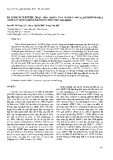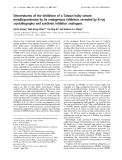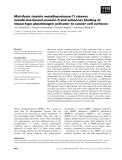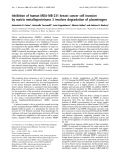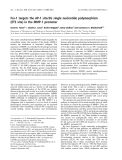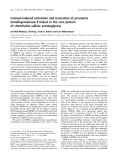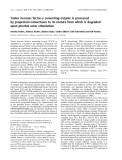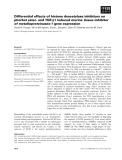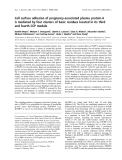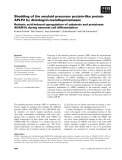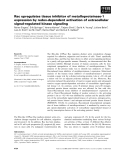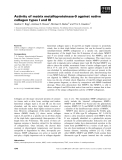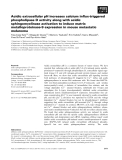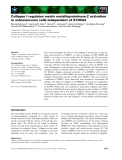
Metalloproteinases
-
Luận án khảo sát mối liên quan giữa khói thuốc lá với biểu hiện gen MMP-12 dẫn đến bệnh nhân bệnh phổi tắc nghẽn mạn tính ở các nhóm nghiên cứu; đánh giá mối liên quan giữa biểu hiện gen MMP-12 với biểu hiện lâm sàng, và với độ nặng của bệnh ở nhóm bệnh nhân bệnh phổi tắc nghẽn mạn tính; mối liên quan giữa biểu hiện gen MMP-12 với dấu hiệu sớm của tắc nghẽn đường dẫn khí nhỏ.
 170p
170p  nguaconbaynhay12
nguaconbaynhay12
 18-06-2021
18-06-2021
 19
19
 5
5
 Download
Download
-
Đa hình nucleotide đoạn điều khiển của matrix metalloproteinase – 2 (MMP – 2) ở một số bệnh nhân ung thư vòm mũi họng
 7p
7p  banhnamdua
banhnamdua
 25-07-2013
25-07-2013
 63
63
 3
3
 Download
Download
-
Venoms from crotalid and viperid snakes contain several peptide inhibitors which regulate the proteolytic activities of their snake-venom metalloproteinases (SVMPs) in a reversible manner under physiological conditions. In this report, we describe the high-resolution crystal structures of a SVMP, TM-3, from Taiwan habu (Trimeresurus mucrosquamatus) cocrystallized with the endogenous inhibitors pyroGlu-Asn-Trp (pENW), pyroGlu-Gln-Trp (pEQW) or pyroGlu-Lys-Trp (pEKW).
 10p
10p  system191
system191
 01-06-2013
01-06-2013
 29
29
 5
5
 Download
Download
-
Matrilysin (matrix metalloproteinase-7) plays important roles in tumor progression. It was previously found that matrilysin binds to the surface of colon cancer cells to promote their metastatic potential. In this study, we identified annexin II as a novel membrane-bound substrate of matrilysin. Treatment of human colon cancer cell lines with active matrilysin released a 35 kDa annexin II form, which lacked its N-terminal region, into the culture supernatant. The release of the 35 kDa annexin II by matrilysin was significantly enhanced in the presence of serotonin or heparin....
 14p
14p  research12
research12
 29-04-2013
29-04-2013
 40
40
 2
2
 Download
Download
-
Matrix metalloproteinase (MMP)-3 inhibited human MDA-MB-231 breast cancer cell invasion through recon-stituted basement membranein vitro. Inhibition of invasion was dependent upon plasminogen and MMP-3 activation, was impaired by the peptide MMP-3 inhibitor Ac-Arg-Cys-Gly-Val-Pro-Asp-NH2 and was associated with: rapid MMP-3-mediated plasminogen degradation to microplas-minogen and angiostatin-like fragments;
 8p
8p  research12
research12
 23-04-2013
23-04-2013
 35
35
 3
3
 Download
Download
-
The matrix metalloproteinase (MMP) family degrades the extracellular matrix. One member of this family, MMP-1, initiates the breakdown of interstitial collagens. The expression ofMMP-1 is controlled by themitogen activated protein kinase (MAPK) pathway(s) via the activity of acti-vator protein-1 (AP-1) and polyoma enhancing activity-3/ E26 virus (PEA3/ETS) transcription factors through con-sensus binding sites present in the promoter.
 10p
10p  tumor12
tumor12
 20-04-2013
20-04-2013
 31
31
 2
2
 Download
Download
-
In the leukemic macrophage cell-line THP-1, a fraction of the secreted matrix metalloproteinase 9 (MMP-9) is linked to the core protein of chondroitin sulfate proteoglycans (CSPG). Unlike the monomeric and homodimeric forms of MMP-9, the addition of exogenous CaCl2 to the proMMP-9/CSPG complex resulted in an active gelatinase due to the induction of an autocatalytic removal of the N-terminal prodomain.
 12p
12p  tumor12
tumor12
 20-04-2013
20-04-2013
 35
35
 3
3
 Download
Download
-
On chemokine stimulation, leucocytes produce and secrete proteolytic enzymes for innate immunedefencemechanisms. Some of these proteasesmodify the biological activity of the chemokines. For instance, neutrophils secrete gelatinase B (matrix metalloproteinase-9, MMP-9) and neutrophil col-lagenase (MMP-8) after stimulation with interleukin-8/ CXCL8 (IL-8). Gelatinase B cleaves and potentiates IL-8, generating a positive feedback.
 11p
11p  tumor12
tumor12
 20-04-2013
20-04-2013
 69
69
 4
4
 Download
Download
-
Tumor necrosis factor-a converting enzyme (TACE or ADAM17) is a member of the ADAM (a disintegrin and metalloproteinase) family of type I membrane proteins and mediates the ectodomain shedding of various membrane-anchored signaling and adhesion proteins. TACE is syn-thesized as an inactive zymogen, which is subsequently proteolytically processed to the catalytically active form.We have identified the proprotein-convertases PC7 and furin to be involved in maturation of TACE.
 8p
8p  fptmusic
fptmusic
 16-04-2013
16-04-2013
 37
37
 3
3
 Download
Download
-
Expression of the tissue inhibitor ofmetalloproteinases-1(Timp-1) gene can be induced by either phorbol myristate acetate (PMA) or transforming growth factorb1 (TGF-b1), although the signalling pathways involved are not clearly defined. Canonically, histone deacetylase inhibitors (HDACi) such as trichostatin A (TSA) or sodium butyrate (NaB) increase total cellular histone acetylation and activate expression of susceptible genes. Remarkably, PMA and TGF-b1 stimulation ofTimp-1show a differential response to TSA or NaB. ...
 15p
15p  awards
awards
 06-04-2013
06-04-2013
 41
41
 4
4
 Download
Download
-
The metalloproteinase pregnancy-associated plasma pro-tein-A (PAPP-A) cleaves a subset of insulin-like growth factor binding proteins (IGFBP), which inhibit the activities of insulin-like growth factor (IGF). Through this proteolytic activity, PAPP-A is believed to regulate IGF bioavailability in several biological systems, including the human repro-ductive system and the cardiovascular system. PAPP-A adheres to mammalian cells by interactions with glycos-aminoglycan (GAG), thus targeting the proteolytic activity of PAPP-A to the cell surface. ...
 11p
11p  dell39
dell39
 03-04-2013
03-04-2013
 53
53
 5
5
 Download
Download
-
Cleavage of the amyloid precursor protein (APP) within the amyloid-beta (Ab) sequence by the a-secretase prevents the formation of toxic Abpep-tides. It has been shown that the disintegrin-metalloproteinases ADAM10 and TACE (ADAM17) act asa-secretases and stimulate the generation of a soluble neuroprotective fragment of APP, APPsa.
 13p
13p  dell39
dell39
 27-03-2013
27-03-2013
 32
32
 4
4
 Download
Download
-
The Rho-like GTPase Rac regulates distinct actin cytoskeleton changes required for adhesion, migration and invasion of cells. Tiam1 specifically activates Rac, and Rac has been shown to affect several signaling pathways in a partly cell-type-specific manner. Recently, we demonstrated that Rac activation inhibits Matrigel invasion of human carcinoma cells by tran-scriptional upregulation of tissue inhibitor of metalloproteinase-1.
 16p
16p  inspiron33
inspiron33
 23-03-2013
23-03-2013
 32
32
 3
3
 Download
Download
-
Interstitial collagen types I, II and III are highly resistant to proteolytic attack, due to their triple helical structure, but can be cleaved by matrix metalloproteinase (MMP) collagenases at a specific site, approximately three-quarters of the length from the N-terminus of each chain.
 10p
10p  galaxyss3
galaxyss3
 21-03-2013
21-03-2013
 31
31
 4
4
 Download
Download
-
Snake venom metalloproteinases (SVMPs) have recently been shown to interact with proteins containing von Willebrand factor A (VWA) domains, including the extracellular matrix proteins collagen XII, collagen XIV, mat-rilins 1, 3 and 4, and von Willebrand factor (VWF) via their cysteine-rich domain.
 11p
11p  galaxyss3
galaxyss3
 19-03-2013
19-03-2013
 42
42
 4
4
 Download
Download
-
Acidic extracellular pH is a common feature of tumor tissues. We have reported that culturing cells at acidic pH (5.4–6.5) induced matrix metallo-proteinase-9 expression through phospholipase D, extracellular signal regu-lated kinase 1⁄2 and p38 mitogen-activated protein kinases and nuclear factor-jB.
 13p
13p  galaxyss3
galaxyss3
 19-03-2013
19-03-2013
 33
33
 5
5
 Download
Download
-
As more data are generated from proteome and transcriptome analyses of snake venoms, we are gaining an appreciation of the complexity of the venoms and, to some degree, the various sources of such complexity. How-ever, our knowledge is still far from complete.
 15p
15p  galaxyss3
galaxyss3
 07-03-2013
07-03-2013
 44
44
 2
2
 Download
Download
-
Matrix metalloproteinase-9 (MMP-9) displays a preference for a broad range of substrates including extracellular matrix proteins and cytokines. MMP-9 plays an important role in physiological processes, as well as in inflammatory diseases and numerous cancers.
 13p
13p  media19
media19
 05-03-2013
05-03-2013
 33
33
 1
1
 Download
Download
-
Although ADAM10 is a majora-secretase involved in non-amyloidogenic processing of the amyloid precursor protein, several additional substrates have been identified, most of them in vitro. Thus, therapeutical approaches for the prevention of Alzheimer’s disease by upregulation of this metalloproteinase may have severe side effects.
 13p
13p  vinaphone15
vinaphone15
 27-02-2013
27-02-2013
 29
29
 2
2
 Download
Download
-
This work investigates the effect of cell–collagen I interactions on the syn-thesis and activation of MMP-2, as well as synthesis of MT1-MMP and TIMP-1, by using anin vitro model with 3D fibrillar and 2D monomeric collagen.
 12p
12p  vinaphone15
vinaphone15
 25-02-2013
25-02-2013
 37
37
 2
2
 Download
Download
CHỦ ĐỀ BẠN MUỐN TÌM










